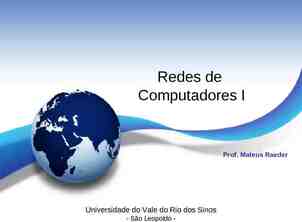Theory of Architecture Fourth Stage Architecture
15 Slides8.06 MB

Theory of Architecture Fourth Stage Architecture Engineering Department

Semiotics Semiotics: It’s the study of non-verbal communication, and how we derive meaning from symbols. A classic architectural example of the fluidity of symbolic representation is how classical Greek columns, the Doric, Ionic, and Corinthian order, receive different responses throughout history. In its inception Doric columns were considered masculine, Corinthian was feminine, and Ionic was neutral. But hundreds of years later during revivalist periods of architecture, when these same columns were built, viewers responded saying that Corinthian was strong and straightforward, or in other words, masculine.

Semiotics Deconstruction is a late 20th century philosophical movement primarily fathered by Derrida. It basically sought to undermine preconceived beliefs surrounding reason and logic. Instead, Derrida argued that meaning, from words, symbols (actually, remember symbols for later—it’s what deconstructivist architecture is founded upon), relationships, the yin and yang between things. a chair is a chair and has meaning to us (the audience) as a chair because we know what isn’t a chair, etc. In addition, the meaning of a thing changes over time. Today, in 2019, a laptop has a particular meaning and significance but will it have the same meaning and significance in a thousand years? Today, if someone showed you a sword or armor, would you actually think they’re taking that thing into battle? Or would you think they just were into collecting antiques? Anyway, the whole point is that the meaning of anything is fluid, always changing based on context, relationships to other things, cultural attitudes, age, time, and other factors too.

Structuralism Structuralism is a 20th Century intellectual movement (it has had an effect on linguistics, sociology, anthropology and other fields in addition to philosophy) that attempts to analyze a specific field as a complex system of interrelated parts. Structuralism holds that all human activity and its products, even perception and thought itself, are constructed and not natural, and in particular that everything has meaning because of the language system in which we operate. It is closely related to Semiotics, the study of signs, symbols and communication, and how meaning is constructed and understood. There are four main common ideas underlying Structuralism as a general movement: every system has a structure the structure is what determines the position of each element of a whole

Structuralism Structuralism is widely regarded to have its origins in the work of the Swiss linguistic theorist Ferdinand de Saussure (1857 - 1913) in the early 20th Century, but it soon came to be applied to many other fields, including philosophy, anthropology, psychoanalysis, sociology, literary theory and even mathematics. In the early 20th Century, Saussure developed a science of signs based on linguistics (semiotics or semiology). He held that any language is just a complex system of signs that express ideas, with rules which govern their usage. Structure characteristics structures are based on the idea of wholeness, thus the vision of the theoretical work as taking apart or putting together isolated elements. structures are systems characterizes by specific dynamics of transformations , through which they develop and change, while keeping certain boundaries.

Waxner Visual Arts Center (1982-1989) Columbus,Unite d Sates Eisenman created a duality in the form of the building by putting a fracture between two parts of the building and showed that none of the two parts has priority to other one; the old site was an old army university, so he designed forms of an army castle on the entrance of the building. The Wexner Center deconstructs the archetype of the castle and renders its

Folding Philosophy Leibniz believes that ‘the fluidity of matter, the elasticity of bodies, and motivating spirit as a mechanism’, cause the elongation of curvature There is a dynamic power, which allocates matter with a curvilinear or spinning movement, by which assembled the universe, and its curvature. the parts of matter from little vortices in turbulence are dividing endlessly, and even more vortices in these divisions, even smaller, and even more are spinning in the concave distances of the swirls that touch one another universe, he called the smallest part (Monade). The division of continuous must not be taken as, for instance, of sand dividing into grains, but as that of a sheet of paper or of p a tunic in folds, in such a way that an infinite number of folds can be produced, some smaller than others, but without the body ever dissolving into points or minima.

Folding in Architecture By the end of 20th century the French theoretician Gilles Deleuze has brought theory of folding in the field of philosophy and opened discussions in different realms such as language, cinema and to some extent in architecture. Architectural designers such as Peter Eisenman, Greg Lynn, Jeffry Kipnis and some others started applying Deleuze’s philosophy in the process of conceptualizing.

What is the Fold in Architecture? Greg Lynn’s idea of fold is animated form, Fold means layer, layers that there is no priority among them. Folding means to assimilate independent matters in a constant mixture Eisenman’s grids and context-based ideas, as he is the founder of Folding architecture discussed the phrase “weak form”, which is a flexible form that adopts itself to the environment. Folding has been discarded verticality, assortment and hierarchy and brings the issue of being horizontal. Shirdel’s ideas of topology as a cultural and scientific resource of folded and twisted architecture. all are working in a conceptual system of architectural practice.

Why do architects use folding in PostModern design? Folding keeps the connections between past and present, since it is a notion that goes back to the history and originally it has no time limits. Being timeless can be assumed as typical object of a certain kind; the window to virtual space is a device, a device of illusion.

Columbus Convention Center, Peter Eisenman, 199092 Eisenman tried to show the multi-layer being of the communication lines and connections in the age of Hypermedia by means of his built form. The layers are the same and vertically located next to each other and the complex of the layers make the whole building as a single structure.

Church of the year 2000 Peter Eisenman The iconography of this church is based on two parallel ideas: one, the proximity and distance inherent in the idea of the pilgrimage and two, the new relationship between man, God, and nature.

Church of the year 2000 Peter Eisenman

City of Culture, Galicia, Spain The fold produces a dislocation of the dialectical difference between figure and the ground; this process leads to creation of a space, which Deleuze called a smooth space. In his work, City of Culture, Eisenman designed an architectural form based on the fold theory, the continuity of lines and figures from the interior to exterior and also from the context of the city map is the visual depiction of his intentions to use the idea of changing that traditionality.

City of Culture, Galicia, Spain






